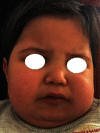Dental Management of a Tunisian Child with Sanjad-Sakati Syndrome
- PMID: 35493399
- PMCID: PMC9054449
- DOI: 10.1155/2022/9585460
Dental Management of a Tunisian Child with Sanjad-Sakati Syndrome
Abstract
Sanjad-Sakati syndrome (SSS) is a rare autosomal recessive congenital disorder. The present case report is aimed at describing the orofacial manifestations and dental management of a 4-year seven-month-old, Tunisian boy with SSS. The patient has typical dysmorphic facial features and growth retardation. Intraoral examination revealed micrognathic mandible and maxilla, an arched palate, and small dental arches with an open bite. All the maxillary and mandibular teeth were decayed due to the poor oral hygiene, plaque accumulation, and enamel hypoplasia. Oral rehabilitation involved pulpotomies and root canal therapies on decayed teeth. Resin composite restorations were performed on maxillary and mandibular incisors, and stainless-steel crowns were placed on maxillary and mandibular first and second primary molars. Dental treatment of children with SSS should improve their quality of life and their general health. Undeveloped dental arches associated with dental anomalies as well as learning deficit make very difficult of the oral rehabilitation of such patients.
Copyright © 2022 Farah Chouchene et al.
Conflict of interest statement
None of the authors has declared any conflict of interest or financial disclosures.
Figures
Similar articles
-
Sanjad-Sakati Syndrome: Oral Health Care.Med Princ Pract. 2018;27(3):293-296. doi: 10.1159/000488352. Epub 2018 Mar 13. Med Princ Pract. 2018. PMID: 29533933 Free PMC article.
-
Oral Facial Manifestations of Sanjad-Sakati Syndrome: A Literature Review.Children (Basel). 2022 Mar 22;9(4):448. doi: 10.3390/children9040448. Children (Basel). 2022. PMID: 35455492 Free PMC article. Review.
-
The dentofacial features of Sanjad-Sakati syndrome: a case report.Int J Paediatr Dent. 2004 Mar;14(2):136-40. doi: 10.1111/j.1365-263x.2004.00527.x. Int J Paediatr Dent. 2004. PMID: 15005702
-
Sanjad-sakati syndrome dental management: a case report.Case Rep Dent. 2013;2013:184084. doi: 10.1155/2013/184084. Epub 2013 Feb 21. Case Rep Dent. 2013. PMID: 23533822 Free PMC article.
-
Endocrinological Manifestations of Sanjad-Sakati Syndrome.Cureus. 2020 Jun 22;12(6):e8770. doi: 10.7759/cureus.8770. Cureus. 2020. PMID: 32714707 Free PMC article. Review.
Cited by
-
Knowledge, Attitude, and Behavior of Parents Regarding Early Childhood Caries Prevention of Preschool Children in Western Region of Saudi Arabia: A Cross-Sectional Study.Dent J (Basel). 2022 Nov 22;10(12):218. doi: 10.3390/dj10120218. Dent J (Basel). 2022. PMID: 36547034 Free PMC article.
References
-
- Hafez M., Anwar G. M., Ibrahim A., Musa N. Sanjad Sakati syndrome: case reports from Egypt. Egyptian Pediatric Association Gazette . 2017;65(1):6–9. doi: 10.1016/j.epag.2017.01.005. - DOI
Publication types
LinkOut - more resources
Full Text Sources




